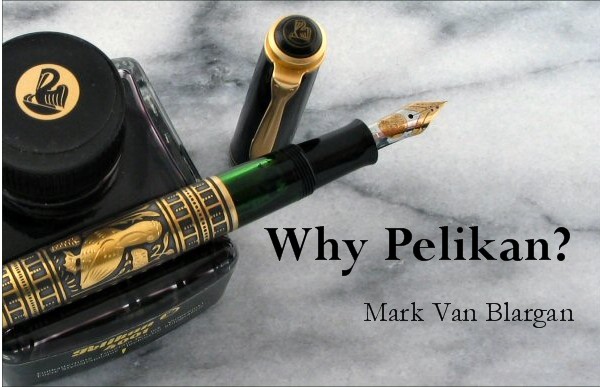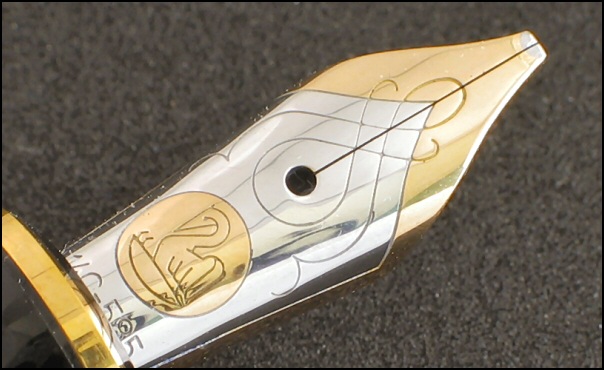|

I collect Pelikan fountain pens mostly because I enjoy writing with Pelikan
fountain pens. Therefore this article explores why I collect Pelikan
pens and why I like to use them. In the interest of full disclosure
I should note that my collecting leans toward post-World War II Pelikans including
current models, so this article is biased in that direction.
A Rocky Start
My relationship with Pelikan had a rocky start. A few years ago, I paid a visit
to my first real pen shop--Joon in New York. I was determined to buy my first
fine fountain pen, but did not yet know much about them. I had used fountain pens
for years with varying degrees of satisfaction, but my purchases were haphazard.
I bought whatever caught my fancy and happened to be in the clearance case of
a local pen shop, among them were pens such as a Lamy Al-Star, Cross Townsend,
Recife PressMaster and two Namiki VPs.
Lacking a clear focus, I relied on the knowledgeable staff at Joon, who suggested
a Pelikan M800 with a medium nib. I dipped the pen and it wrote well, so I purchased
it, some Waterman blue-black ink (my first ink in a bottle and to this day my
favorite ink) and hurried back to my hotel room. There I tried to remember how
to fill the pen without spilling ink all over, eventually got it filled, and excitedly
started to doodle. After the first few lines…nothing, nada, zip. The pen
would not write. Thoroughly disgusted, I concluded, based on a grand sample of
one, that all Pelikan pens stank. I moved on to exploring other brands of pens
in my quest for Fountain Pen Nirvana, the One True Pen.

My first Pelikan, an M800
Eventually I stumbled on John Mottishaw’s site, called and ordered a
new, fine M800 nib from his delightful assistant Pat (I had not yet heard about
free nib exchanges). Pat had promised me that they could make a nib “glassy
smooth” and personally adjusted to my writing style. She lived up to her
promise. That M800 became my favorite pen.
The Flock Breeds
While I continued to accumulate other brands of pens, over time I found myself—without
much conscious thought--purchasing a disproportionate number of Pelikans in different
shapes and sizes.
Eventually, I realized that on most days, I carried at least one Pelikan and had
enough Pelikans to start calling them a "collection." From that point
on, my flock of Pelikans began to breed (it had to be breeding, since there’s
no way I actually could have purchased all of those pens).
I have now collected quite a number of Pelikan pens ranging from a Culture “school
pen” at the low end to a Pelikan Expo 2000 Technology Special Edition at
the high end.

Top, Culture; bottom, Expo 2000 “Technology”
What impresses me about the Pelikan line is their design, quality/writing
experience, and depth and breadth of models.
Design
Overall, Pelikan designs pens better than most other manufacturers, assuming you
are interested more in how well a pen writes and feels in your hand, than eye
candy or pen jewelry. My favorite design features, below, apply to the current
Souveran models, (M400, M600, M800, M1000) the work-horse Tradition (150 and 200)
series, and to most of the vintage pens:
Interchangeable nibs. The feed/nib assemblies on all these Pelikans
screw out, which makes them interchangeable between pens of the same series. This
is a great advantage since you can have multiple nibs with a single body, or swap
nibs between and among pen holders. This is a great way to try out custom ground
“exotic” nibs such as stub or cursive italics. Warning: Some care
is required to remove the feed/nib assembly so as not to damage it. Specific instructions
on how to do that are beyond the scope of this article, however this
Pen Doctor column tells you how.

Double broad cursive italic nib
Visible ink supply. All of the Pelikan pens have some way to tell
how much ink is in the pen, whether by removing the barrel to see the cartridge/convertor,
by looking at an ink-window, or, with a wee bit of practice, by looking between
the solid and translucent parts of a striped barrel. For me, that’s an important
consideration. I really do not like running out of ink in the middle of a meeting.
One turn—and ready for writing. To quote an early Pelikan pen
ad: “No turning, turning and still more turning—just one turn of the
cap suffices. Nevertheless, the Pelikan pen closes firmly, for the screw has a
quadruple thread, which acts in four different places. Can you imagine a quicker
manipulation of a fountain pen?” Caps which unscrew quickly are a godsend
for taking sporadic notes. Some people complain that the caps come off a little
too easily in the pocket. As long as the cap is snugged on with a just a slight
bit of torque you will never have a problem
Easy to clean. Most Pelikans are piston-fillers. Overall, I’ve
found piston-fillers to be the quickest, least messy pens to clean. Just fill
the ink-chamber with water and empty a few times.
The Goldilock’s Effect. You know the story. Goldilocks gets
lost in the woods, visits the bear’s house when they are out and plays with
their fountain pens. Daddy’s M800 is too big, baby’s M400 is too small,
and Mommy’s M600 is just right.

Top, M300; bottom, M1000
Appearance. Pelikan designs its pens conservatively, with most of
them aimed at the professional, business set. Some view that design choice as
boring. Personally, I view it as classic, understated and timeless.
Quality/Writing
In my view, quality control sucks at all of the major fountain pen manufacturers.
No matter what brand of pen you buy, including Pelikan, there’s a good chance
it won’t write well out of the box (OOTB). Sadly, that’s one of the
dirty little (not so secret) secrets of our hobby. Given that, Pelikan pens tend
to be better made, and with better quality control than most other pens. In other
words, with a Pelikan, you’re more likely to get a good writer OOTB than
with other brands. Also, the fit and finish tends to be good, if not excellent,
even on the “cheapie” models.
Happily, Pelikan has been making quality pens from the start, so a vintage
400 or 400NN is likely to write as well now as it did when new.
Generally, Pelikan nibs are firm (or pleasantly “springy” in the
larger sizes) and write a consistent, wet line. The nibs tend to run wide and
have a slight “tooth” (a positive I think for better overall performance
across a variety of papers). Many of the vintage Pelikans are equipped with semi-flexible
or oblique nibs.
Depth and Breadth
Pelikan has been making pens for the past seventy-five years. While they have
haven't introduced nearly as many models as other makers, there’s a lot
of breadth to the sub-markets they’ve covered, and lot of depth to some
of the series they have issued. That Pelikan chose (by and large) to focus on
offering a few good models also attracts me, because it makes it easier to get
a handle on what is in the Pelikan universe and how different parts of that universe
relate to one another.
Therefore, once you’ve figured out how the Goldilocks Effect applies
to you, you can start delving into the many variations available for each of the
basic models of pens. For me, the M600 fits my hand best. Happily, Pelikan has
been issuing at least two new variations per year based on the M600 as part of
the “Cities Special Edition Series.” As I write, Pelikan has issued
five in the series, the Berlin, Stockholm, Madrid, San Francisco and Chicago.
Including the Cities Series, Pelikan has issued fifteen different variations of
the M600.

Pelikan Cities Series
If you like a slightly smaller pen, consider the M400, the 200 (which are
the same size as the M400 only injection molded and with less gold trim and a
gold-plated nib), the 250 (same as the 200 except with a gold-nib), or the M700
series (high end variations of the M400). If you look around there are some unusual
variations for each of these lines. For example, I’ve managed to add 20
variations of the 200/250 models, and I know there are others around.
 Back to List | First
| Previous
| Last Back to List | First
| Previous
| Last
|